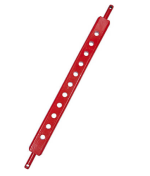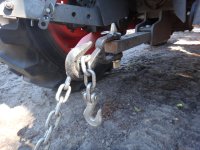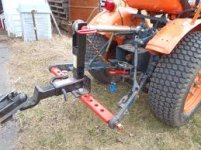Working Draft
1.1
CROSS-DRAWBAR

CROSS-DRAWBAR
A tractor cross-drawbar mounts through the "bullseyes" integral to the left and right Lower Links of the Three Point Hitch then secured with lynch pins. An inexpensive fitting, known as a drawbar lock, Photo #1, couples the cross-drawbar and one Lower Link to prevent the cross-drawbar from twisting/turning on its axis. Alternately to a drawbar lock, a substantial vertical component, Photo #2, is bolted to the cross drawbar, adding a Top Link connection and a receiver hitch at the base. A third option is an integrated,
triangulated cross-drawbar, Photo #3, which includes a Top Link connection. Option three is the high value hardware.
Cross-drawbars are readily available in 20" width for subcompact tractor, 26" width for Category 1 compact tractors and 38" width for Category 2 tractors. Cross-drawbars accept accessory clevis and bolt-on installations. Several attachments are visible in photos. Mild steel is used for cross-drawbars so they bend, gently, rather than fail catastrophically under a heavy load.
A cross-drawbar allows elevation of pulled loads using Three Point Hitch hydraulic power. With 4" to 6" of elevation loads are unlikely to encounter obstructions either stopping the tractor or driving the tractor vertical if the operator in not alert.
(I once had a Deere 750 vertical, towing timbers from the rear/center drawbar.)
With loads elevated less of the load is in ground contact, decreasing friction of the load against the ground and preventing the load from plowing dirt. In some circumstances elevation permits heavier loads to be pulled.
Photos #4 - #6.
The disadvantage of a cross-drawbar is its integration with the Three Point Hitch, a weaker connection point than the tractor frame/chassis. An imprudent operator could damage the Three Point Hitch with imprudent loads or imprudent operation. With loads perpendicular to a cross-drawbar substantial strain is placed on perforated, mild steel bar. Most cross-drawbars in use for some time show distortion but remain functional; mine included, Photo #2.
Any time you are pulling a load with a tractor, the load is trying to pull the tractor over backward. The Three Point Hitch relies on "tongue weight" (mass of the load bearing down on the Lower Links) for vertical stability. The Three Point Hitch does not include a latch to prevent unanticipated upward movement of the Lower Links, cross-drawbar and a wheeled load. Photo #7.
Sudden reversal of tongue weight may occur as cart load is pulled up a slope, over uneven ground, if a cart is inadvisedly loaded at the rear first rather than the front or center first, or if someone steps on rear of the load, shifting weight distribution to the rear. Caution with two-wheeled drawn implements is also advised, for identical reasons. The potential for load upset, tractor upset and human injury is there.
The Three Point Hitch and optional cross-drawbar are designed to pull heavy loads at or below rear axle height, over level ground, with minuscule risk of a backward upset. When the cross drawbar is raised above rear axle height, the potential for a backward upset increases. Always position Lower Links and cross-drawbar at the level of the rear axle or as low as conditions permit.
REAR/CENTER DRAWBAR

REAR/CENTER DRAWBAR
Integral to the tractor is a rear/center drawbar which is attached directly to the tractor frame/chassis. Rear/center drawbar does not elevate; it is fixed. Rear/center drawbar in photo has a clevis mount chain grab hook attached, a ubiquitous fitting. (Rear/center drawbar is often a new tractor factory option on lighter tractors.)
The advantage of the rear/center drawbar is its fixed attachment to the tractor frame/chassis, the strongest connection possible. On my kubota
L3560 the rear/center drawbar is always in place. The rear/center drawbar does not interferes with Three Point Hitch implements nor the mounted cross-drawbar.
If you must pull a cart or two wheeled implement over uneven ground or up a slope, bolt on appropriate size hitch-ball to the fixed rear/center drawbar.
Photo #2 ~ Omni Mfg., LLC, Deerwood, MN Combo Draw Bar Trailer vertical component. (2/2012)
LINK:
Combo Hitches - OMNI Mfg LLC
Photo #3 ~ Triangle Cross-Drawbar Hitch
LINKS (2):
3 point hitch drawbar in Heavy Equipment, Parts & Attachments | eBay
Tractor 3 Point Hitch Adapter, tractor hitch adapter
Google Images:
TRACTOR cross drawbar - Google Search











